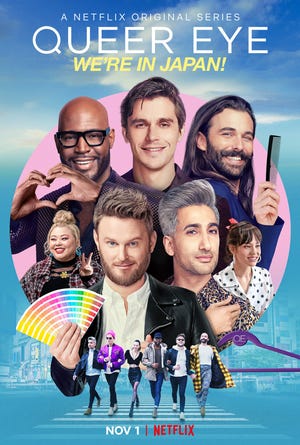Queer Eye: We’re in Japan! shows that everyone, no matter where they live or who they are, deserves to love and have confidence in themselves
In the streets of bustling and hectic Tokyo, Japan, five men and a Japanese model—all dressed in colorful clothing—strut across the middle of the street and catch the viewers’ eyes. The group completely contrasts their pale blue and gray surroundings: bleak buildings, people dressed in bland colors, and an uninteresting sky.
This opening scene of Queer Eye: We’re in Japan! sets the tone for the rest of the episodes: the Fab 5 and Kiko are a beacon of light, color, and happiness in four struggling lives.
Queer Eye: We’re in Japan! serves as the series’ fifth season. With only four episodes, I expected the season to fall short compared to other seasons; however, the Fab 5 was very successful in continuing to portray the theme gaining power behind self-acceptance and confidence. Although there were obvious barriers such as differences in the native language and cultural norms, the Fab 5 respectfully altered the lives of four Japanese men and women for the better.
The Netflix Original TV show features a group of four gay men and one non-binary person who each possess a certain skill that they utilize to completely transform and improve the lives of the individuals that are featured on the show. Bobby Berk (building), Jonathan Van Ness (grooming), Karamo Brown (culture), Antoni Porowski (food and wine), and Tan France (fashion) make up the cast of the Queer Eye episodes.
But, for the Japan season, American-Japanese model, actress, singer, and designer Kiko Mizuhara (Tokyo guide) assists the group in the transformations. Also, the last of the four episodes feature Japanese comedian, actress, and fashion designer Naomi Watanabe.
The four individuals the group assists each struggle with heavy issues such as a failing marriage, a fear of coming out, a battle with finding purpose after the death of a loved one, and the depression from being bullied as a child that was carried into their adulthood. As a viewer, it was inspiring to witness the individuals being open and vulnerable about their baggage, and it was even more heartwarming to view the responses from the Fab 5.
The Fab 5 were truly talented at conveying to the four people they helped the message that, although members of the Fab 5 had not gone through a completely identical situation, they had, in fact, experienced a situation very similar to the one that the four people were toiling through.
For example, in the third episode, young adult Kae and her mother simply do not have a relationship with each other, and Antoni assists with their situation by encouraging Kae’s mother to attempt to understand Kae’s sadness and to be more acceptive of Kae. Through his own experiences growing up, Antoni learned that children often do not transparently express their feelings to their parents, and through the lessons he gained from his personal experiences, he was able to successfully salvage a failing relationship.
Overall, the ability that the Fab 5 possesses to drastically improve the lives of the individuals that they feature on their show is incredible.
But, their ability to convey those important messages through a screen and make those messages personal—and almost directed at the viewer—is simply amazing.

Morgan Mittlestadt is entering her second year on staff for The Central Trend. This year, she will be acting as a Social Media Manager for the site. She...

























































































